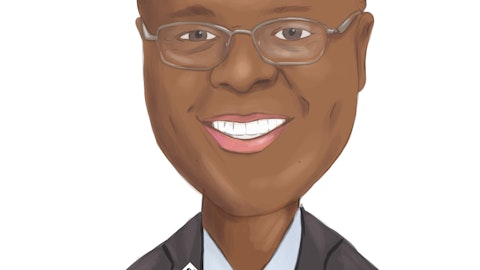But then at that point, I think that it, kind of flattens out as we go through the second half of the year again based on the rate assumption we described earlier.Catherine Mealor Great. Very helpful. Thank you.John Hairston You bet. Thank you. Appreciate the questions.Operator Your next question comes from Michael Rose with Raymond James. Your line is open.Michael Rose Hey, good afternoon. Thanks for taking my questions. Certainly understand the FHLB build. Mike, if you can just give us a sense for how long you might expect that to maybe stick around and maybe what the term is on that? Just trying to get a sense for impact on average balances things like that? Thanks.Mike Achary Sure. I’d be glad to Michael. So, the liquidity that we added to the balance sheet late quarter again was about 1.2 billion in home loan advances.
Those advances were really split into a 30-day piece and a 45-day piece. For the most part, all priced at just a little bit north of 5%, and then of course, we added the brokered CDs as we mentioned earlier.So yes, you’re right. I mean the big question is, how long do we keep that extra liquidity on the balance sheet? And the shorter answer is, we’ll keep it for as long as it takes to, kind of get through any potential period of additional stability. If that happens, in the banking environment going forward, I do think though that when it’s all said and done on a go forward basis, we’ll probably keep a little bit extra liquidity going forward than we probably did before, let’s say, March 10. How much that ends up being, again, it really just kind of depends on what the environment looks like.Michael Rose Perfect.
Appreciate that color Mike. Maybe one for Chris. Noticed that the non-accrual loans ticked up just a little bit, just – I know we’re going off a really low base here, but any, sort of discernible trends because it looks like criticized classified was down, so just trying to get some color there? Thanks.John Hairston Yes, no worries, Michael. Thanks for the question. Yes, I mean, as you pointed out, we really are operating at a relatively low base. I mean, it really is at historical low levels. And so any sort of movement in non-accruals may seem significant, but realistically it was just really one account that we’ve been – one major account, if you want to call it that that we’ve been following for probably a year now where we’ve been, kind of working through a strategy to recast the loan and in the process we had to move it into non-accrual, but not a real significant issue in our non-accruals.Michael Rose Perfect.
Thanks guys. I’ll hop back in queue.John Hairston Thank you.Operator Our next question comes from Kevin Fitzsimmons with D.A. Davison. Your line is open.Kevin Fitzsimmons Hey, good afternoon everyone.John Hairston Good afternoon.Kevin Fitzsimmons I appreciate the guide on margin and NII. Is it fair to – given the steps taken and how late in the quarter it was on boosting liquidity, get the brokered CDs, the FHLB, while we still have ongoing the DDA shift, is it fair to expect that the continuation of percentage margin compression in the second quarter would be more substantial than what you saw in first quarter? Is that a fair assumption?Mike Achary Kevin, this is Mike. Not necessarily. I do think that the margin compression that we are looking at potentially for the second quarter is probably somewhere around the magnitude of what we saw in the first quarter, compared to the fourth quarter.
So, I don’t know that it will be necessarily more than the 13 basis points, but probably somewhere in that neighborhood. Kevin Fitzsimmons So Mike, can you just go through some of the puts and takes on that? Because just you definitely look liquidity and stability to balance sheet is top priority and I recognize the steps you took, but it seems like, is there more a loan repricing coming or is it – I’m just trying to think the positive offsets to more of the wholesale and brokered funding?Mike Achary Yes. Well, I think some of it is, I don’t know necessarily we have built into the second quarter forecast, the same 2.9 billion of excess liquidity. So that does come down a little bit as we go through the second quarter. And again, as I mentioned earlier, whether we keep it at the current level, bring it down a little bit or bring it down significantly is really just going to depend on the operating environment.The other things I think certainly could be helpful as we think about the second quarter NIM is, we have built into our forecast the Fed raising rates another 25 basis points.
So there’s some beneficial impact of that related to our variable rate loans. We received a nice cumulative impact from the overall repricing of all of our fixed rate loans. So, there’s a slide in the deck that talks about the yields that we’re getting in terms of loans due to the balance sheet.So, for the fixed rate loans, that’s nearly 6.5% and that’s not insignificant. And continues to build, kind of on a cumulative basis going forward. The other thing is, we have pretty attractive CD pricing being offered right now. And I think again, depending on the amount of stability we have in the environment, we’re likely maybe to come off some of that. So, those are all things that I think will help and build the case a little bit for the NIM not narrowing much more than it did in the first quarter.Kevin Fitzsimmons Okay.
Very helpful. Thanks, Mike. Just thinking about the percentage of DDA and where that settles and if it comes down to the high 30s, do you – you kind of mentioned year-end, do you think assuming the Fed has one more move to go? Does that pace, like it continues that mix shift, but at a diminishing pace over the balance of the year is your best guess?Mike Achary Yes, absolutely. I think that [remix] [ph] of deposits will continue as we go through the year. If the Fed does raise rates one more time and then goes to the sidelines, then I do think that remix has the potential to slow a little bit from the levels that we saw the last couple of quarters.John Hairston Kevin, this is John. Just one thing to add to the algebra. As the account balances move from the pandemic highs to the pre-pandemic norms, which seem to be on track for both consumer and business purpose accounts for the middle of 2024.
There’s a bit less money that would be set aside in chunks and side CDs because people don’t think they’re going to need it for a period of time.So, even though consumer spending is strong, the types of spending is more necessities versus large ticket items like it was the last couple of years. So, there’s a likelihood that people put less money into CDs over the course of the next 4 quarters to 6 quarters that occurred in the past 4 months to 6 months, if that makes sense. So, there would be some natural pace simply because the degree of excess goes away. And so, the closer we get to norm, the closer we get to norm in all matters of the balance sheet. I hope that makes sense.Yes, the other driver is, as rates go up and revolving line cost goes up, excess liquidity seems to find its way towards paying down that debt.
I mean, why have it sit in a bank if you can use it to decrease your cost, right? So, as you saw for the first time and really about two years, we saw a decrease in line utilization and that’s predominantly coming from people using the remaining excess liquidity pay down debt.So, those two things I think are a little outsized based on the poking of the rate there so to speak by the Fed’s pace of interest rate increases. So, as they slow, and as the account sizes normalize, we should see some degree of mitigation and the pace that we’re seeing migrate from an [indiscernible] to something else. Hopefully that makes sense.Kevin Fitzsimmons Yeah, that’s great. Thank you guys.Operator Our next question comes from Brandon King with Truist. Your line is open.Brandon King Hey, good afternoon.John Hairston Good afternoon, Brandon.Brandon King Yes.





